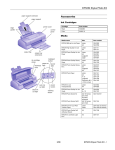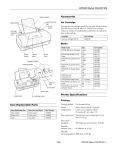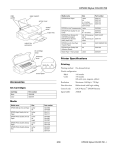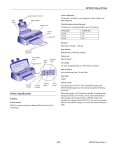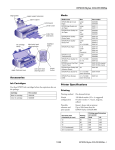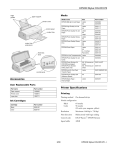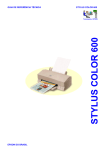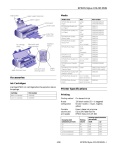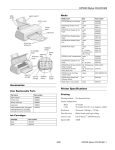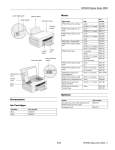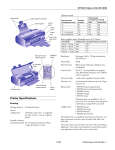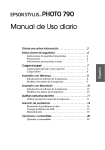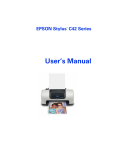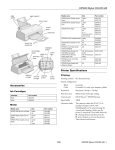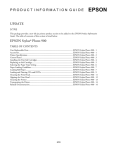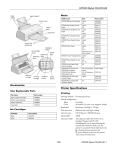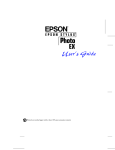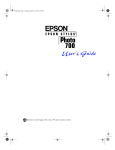Download Epson Stylus Photo 700 Ink Jet Printer Product Information Guide
Transcript
EPSON Stylus Photo 700 paper support extension edge guides Accessories paper support Ink Cartridges printer cover control panel output tray extensions paper out load/eject light button thickness lever black ink out light color ink out light cleaning button Part number Black S020093 Color S020110 Media output tray ink cartridge clamp Cartridge power button Media name Size Part number EPSON 360 dpi Ink Jet Paper Letter A4 S041060 S041059 EPSON High Quality Ink Jet Paper Letter A4 S041111 S041117 EPSON Photo Quality Ink Jet Paper Letter A4 Legal S041062 S041061 S041067 EPSON Photo Quality Glossy Paper Letter A4 S041124 S041126 EPSON Photo Quality Glossy Film Letter A4 A6 S041072 S041071 S041107 EPSON Photo Paper Letter A4 4×6 Panoramic (8.3 × 23.4 inches) S041141 S041140 S041134 S041145 EPSON Ink Jet Transparencies Letter A4 S041064 S041063 EPSON Photo Quality Ink Jet Cards A6 8 × 10 S041054 S041122 EPSON Photo Sticker Kit A6, 16 frames per sheet (includes software) A6, 16 frames per sheet S041144-KIT EPSON Iron-On Cool Peel Transfer Paper Letter Letter S041153 (10 sheets) S041155 (50 sheets) EPSON Photo Quality Self Adhesive Sheets A4 S041106 EPSON Photo Sticker Refill 3/98 S041144 EPSON Stylus Photo 700 - 1 EPSON Stylus Photo 700 Ink Cartridge Printer Specifications Printing Printing method EPSON’s exclusive drop-on-demand Micro Piezo™ ink jet technology Specification Black ink cartridge (S020093) Color ink cartridge (S020110) Color(s) Black Cyan, Magenta, Yellow, Light Magenta, Light Cyan Print capacity* 540 pages/A4 (ISO/IEC 10561 Letter Pattern at 360 dpi) Nozzle configuration 220 pages (A4, 360 dpi, 5% duty each color) Black 32 nozzles Cartridge life Color 32 nozzles × 5 (cyan, magenta, yellow, light cyan, light magenta) 2 years from production date (if unopened) (within 6 months after opening package, at 77 °F (25 °C)) Storage temperature Installed: Transit temperature −22 to 140 °F (−30 to 60 °C) 1 month at 104 °F (40 °C) 120 hours at 140 °F (60 °C) Printable columns and printing speeds Print quality Printable width Available dots CR speed 180 dpi 8.26 inches (209.8 mm) 1488 20 ips 360 dpi 8.26 inches (209.8 mm) 2976 20 ips 720 dpi 8.26 inches (209.8 mm) 5952 20 ips 1440 dpi 8.26 inches (209.8 mm) 11904 20 ips Freezing 5 °F (−15 °C) temperature** Dimensions dpi = dots per inch, ips = inches per second Resolution Maximum 1440 dpi × 720 dpi Print direction Bidirectional with logic seeking Control code ESC/P Raster™ −4 to 104 °F (−20 to 40 °C) 1 month at 104 °F (40 °C) Uninstalled: −22 to 104 °F (−30 to 40 °C) 1 month at 104 °F (40 °C) 0.7 (W) × 2.1 (D) × 1.5 (H) inches 19.8 (W) × 52.7 (D) × 38.5 (H) mm 1.4 °F (−17 °C) 2.0 (W) × 2.1 (D) × 1.5 (H) inches 51.4 (W) × 52.7 (D) × 38.5 (H) mm * The print capacity may vary, depending on how often you clean the print head. ** Cartridges thaw and are usable after approximately 3 hours at 77 °F (25 °C). Caution: EPSON recommends the use of genuine EPSON ink cartridges. Other products not manufactured by EPSON may cause damage to your printer not covered by EPSON’s warranties. Do not use an ink cartridge if the date on the package has expired. 2 - EPSON Stylus Photo 700 3/98 EPSON Stylus Photo 700 Paper Paper type Size Paper types Thickness Weight Single sheets Letter (8.5 × 11 inches) Legal (8.5 × 14 inches) Statement (5.5 × 8.5 inches) Executive (7.5 × 10 inches) A4 (210 × 297 mm) A5 (148 × 210 mm) B5 (182 × 257 mm) Plain bond paper and special ink jet papers distributed by EPSON 0.003 to 0.004 inch 17 to 24 lb (64 to 90 g/m2) for plain (0.08 to 0.11 mm) for plain bond paper bond paper Transparencies, Glossy film, Glossy paper Letter (8.5 × 11 inches) A4 (210 × 297 mm) A6 (105 × 148 mm), glossy film only Transparencies, glossy paper, and glossy — film distributed by EPSON — Adhesive sheets A4 (210 × 297 mm) Self adhesive sheets distributed by EPSON — — Envelopes No. 10 9.5 × 4.1 inches (240 × 104 mm) Plain bond paper or air mail paper DL 8.7 × 4.3 inches (220 × 110 mm) C6 4.4 × 6.4 inches (114 × 162 mm) 0.006 to 0.017 inch (0.16 to 0.43 mm) 12 to 20 lb (45 to 75 g/m2) Index (ink jet) cards A6 (105 × 148 mm) 8 × 10 inches (203 × 254 mm) Ink jet cards distributed by EPSON — — Photo paper Letter (8.5 × 11 inches) A4 (210 × 297 mm) 4 × 6 inches (102 × 152 mm) Panoramic (210 × 594 mm) Photo paper distributed by EPSON — — Photo stickers A6 (105 × 148 mm) 16 frames per sheet Photo stickers distributed by EPSON — — Iron-on cool peel transfer paper A4 (210 × 297 mm) Letter (8.5 × 11 inches) Transfer paper distributed by EPSON — — Note: Since the quality of any particular brand or type of paper may be changed by the manufacturer at any time, EPSON cannot attest to the quality of any non-EPSON brand or type of paper. Always test samples of paper stock before purchasing large quantities or printing large jobs. Poor quality paper may reduce print quality and cause paper jams and other problems. If you encounter problems, switch to a higher grade of paper. Do not load curled or folded paper. Use special papers distributed by EPSON under these conditions: Temperature: 59 to 77 °F (15 to 25 °C) Humidity: 40 to 60% RH Store printouts on EPSON glossy media and self adhesive sheets under these conditions: Temperature: 59 to 86 °F (15 to 30 °C) Humidity: 20 to 60% RH 3/98 EPSON Stylus Photo 700 - 3 EPSON Stylus Photo 700 Printable area A A B-L B-R B-L C B-R EPSON Panoramic Photo Paper A: The minimum top margin is 0.12 inch (3.0 mm). B-L, The minimum left margin is 0.12 inch (3.0 mm). B-R: The minimum right margin is 0.54 inch (14.0 mm). C: The minimum bottom margin is 0.12 inch (3.0 mm). C single sheets/index cards Note: Always load paper into the sheet feeder short edge first. However, envelopes should be loaded long edge first. A B-L Mechanical B-R C envelope A: The minimum top margin is 0.12 inch (3.0 mm). When loading multiple sheets of EPSON Photo Quality Film, the minimum top margin is 1.2 inches (30 mm). B-L, B-R: The minimum left and right margins are 0.12 inch (3.0 mm). The minimum right margin for envelopes is as follows: 0.28 inch (7 mm) for DL envelopes. 1.10 inch (28 mm) for No. 10 envelopes. 0.12 inch (3 mm) for C6 envelopes. C: The minimum bottom margin is 0.54 inch (14.0 mm). . Paper feed method Friction Paper path Rear entry sheet feeder Sheet feeder capacity 100 sheets of 17 lb (64 g/m2) paper Dimensions Storage Width: 16.9 inches (429 mm) Depth: 9.2 inches (234 mm) Height: 6.4 inches (162 mm) Printing (standard) Width: 16.9 inches (429 mm) Depth: 22.9 inches (582 mm) Height: 12.1 inches (307 mm) A Printing (on transparencies) Width: 16.9 inches (429 mm) Depth: 26.1 inches (664 mm) Height: 7.7 inches (196 mm) B-L, B-R Weight C EPSON 4 × 6-inch Photo Paper (dotted lines indicate perforations) A: B–L, B–R: C: The maximum top margin is 0.67 inch (17.0 mm). The maximum left and right margin is 0.24 inch (6.1 mm). The maximum bottom margin is 0.24 inch (6.1 mm). 4 - EPSON Stylus Photo 700 3/98 11.5 lb (5.2 kg) without the ink cartridges EPSON Stylus Photo 700 Electrical Hardware initialization Specification 120 V Model 220−240 V Model* Input voltage range** 99 to 132 V 198 to 264 V Rated frequency range 50 to 60 Hz Input frequency range 49.5 to 60.5 Hz Rated current 0.4 A Power consumption Approx. 15 W (ISO/IEC 10561 Letter Pattern) Approx. 5 W in standby mode (120 V model) Approx. 5.5 W in standby mode (220−240 V model) When the printer is turned on, the printer mechanism is initialized and the input data buffer and print buffer are cleared. Printer settings are returned to their default values. However, the printer mechanism is not initialized if the printer is turned on within ten seconds after turning it off. In this case, the printer caps the print head, and ejects any paper in the paper path. Software initialization 0.2 A Software initialization clears the print buffer and returns printer settings to their default values. However, it does not initialize the printer mechanism or clear the data buffer. Interface * This product is also designed for an IT power system phase-tophase voltage of 220−240 V. Your printer is equipped with an 8-bit parallel interface and a serial interface. ** Check the label on the back of the printer for the voltage of your printer. Parallel interface Environmental The built-in parallel interface has the following characteristics: Temperature Forward channel Operation 50 to 95 °F (10 to 35 °C) Storage* −4 to 140 °F (−20 to 60 °C) 1 month at 104 °F (40 °C) 120 hours at 140 °F (60 °C) Humidity (without condensation) Operation 20 to 80% RH Storage* 5 to 85% RH Data format: 8-bit parallel, IEEE-1284 compatibility mode Synchronization: STROBE pulse Handshake timing: BUSY and ACKNLG signals Signal level: TTL compatible Connector: 57-30360 Amphenol connector or equivalent *Stored in shipping container Reverse channel Safety approvals Transmission mode: IEEE-1284 Nibble mode Safety standards UL 1950 with D3, CSA C22.2 No. 950 with D3 Adaptable connector: 57-30360 Amphenol connector or equivalent EMC FCC part 15 subpart B class B, CSA C108.8 class B Synchronization: Refer to the IEEE-1284 specification Handshaking: Refer to the IEEE-1284 specification Signal level: IEEE-1284 Level 1 device Initialization The printer can be initialized (returned to a fixed set of conditions) in these ways: Hardware initialization ∗ The printer is turned on. ∗ The printer receives an INIT signal from the parallel interface. Software initialization ∗ Software sends an ESC @ (initialize the printer) command. Data transmission timing: Refer to the IEEE-1284 specification 3/98 EPSON Stylus Photo 700 - 5 EPSON Stylus Photo 700 Serial interface The printer’s built-in serial interface is based on the RS-423 standard. This interface has the following characteristics: Standard: Based on RS-423 Synchronization: Synchronous Bit rate: Approx. 1.8 Mbps Handshaking: X-ON/X-OFF and DTR protocol Word format: Data bit: 8 bits Parity bit: None Start bit: 1 bit Stop bit: 1 bit Connector 8-pin mini-DIN Recommended cable: Apple System Peripheral-8 cable (part number M0197) Control Panel power light paper out light black ink out light B or A When an ink out light comes on, you need to replace the ink cartridge. P The power light is on when the printer is on. The power light flashes when the printer is receiving a print job or performing a maintenance operation such as cleaning a print head. PSBA When the power and paper out lights flash and the ink out lights are on, your printer has a carriage error. Turn off the printer by pressing the P power button; wait several seconds; then turn it on again. If this does not clear the error condition, contact EPSON as described in the User’s Guide. PSBA When all the lights flash, your printer may have an internal error. Turn off the printer by pressing the P power button; wait several seconds; then turn it on again. If this does not clear the error condition, contact EPSON as described in the User’s Guide. Installing an Ink Cartridge for the First Time 1. Plug the power cord into a grounded outlet. 2. Make sure the power is off (the P power light is off). color ink out light cleaning button load/eject button power button Caution: Don’t use an outlet controlled by a wall switch or timer, or one that uses the same circuit as a large appliance. This may disrupt the power, which can erase memory or even damage the power supply. The four lights on your printer’s control panel show the printer’s status and alert you to problems like paper jams. S When the paper out light comes on, your paper ran out or is incorrectly loaded. Load paper in the sheet feeder and then press the E load/eject button. S When the paper out light flashes, you have a paper jam. Take all of the paper out of the sheet feeder, reload the paper, then press the E load/eject button. If the light continues to flash, turn off the printer and gently pull out any jammed paper. B or A 3. Lower the output tray and open the printer cover. printer cover power button output tray When an ink out light flashes, your ink supply is low. Make sure you have a replacement cartridge. 6 - EPSON Stylus Photo 700 3/98 EPSON Stylus Photo 700 The printer moves the print head and begins charging the ink delivery system. Charging can take up to two minutes. During this time, the P power light flashes, and the printer makes various sounds. Don’t turn off the printer or interrupt the charging process or you’ll use more ink than necessary. Charging is complete when the P power light stops flashing and is continually lit. 4. Press the P power button to turn on the printer. The P power light flashes, the B and A ink out lights come on, and the ink cartridge holders move left to the installation position. Caution: Always use the P power button to turn the printer on or off. Never use an external switch—such as a power strip—to turn off the printer. Caution: Never turn off the printer when the P power light is flashing. But if the light is still flashing after five minutes and the printer isn’t moving or making noise, you may turn off the printer. 5. Pull up the two ink cartridge clamps. (The illustration shows the color ink cartridge clamp.) Testing the Printer You can run a printer check to determine whether a problem comes from the printer itself or some other source. ❏ If the results are satisfactory, the problem lies in software settings, the interface cable, or your computer. ❏ If the printer check does not print correctly, there is a problem with your printer. 6. Remove the ink cartridges from their foil packages. Then remove only the yellow part of the tape seal on the top of each cartridge. Do not remove the white part. Follow these steps to check the printer: 1. Make sure both the printer and computer are turned off. 2. Disconnect the interface cable from the printer. Caution: You must remove the yellow tape seal from the top of the cartridge or you will permanently damage it. It’s OK if the tape does not exactly tear off along the dotted line. Don’t remove the tape seal from the bottom. 3. Make sure paper is loaded in the printer. 4. Hold down the E load/eject button and press the Ppower button. Hold down the buttons until the Ppower light starts to flash. Then release both buttons. don’t remove don’t remove The printer prints one page containing the printer’s ROM version, ink counter code, character table number, and a nozzle check pattern. Only the nozzle check pattern is shown below: remove remove black ink cartridge 5. After it prints the page, turn off the printer. Remember to reconnect the interface cable, then turn on the printer and your computer. color ink cartridge Warning: If ink gets on your hands, wash them thoroughly with soap and water. If ink gets in your eyes, flush them immediately with water. 7. Insert the ink cartridges into their holders. Be sure the labels are face up and the arrows point toward the back of the printer. The black ink cartridge goes on the left and the color ink cartridge goes on the right. 8. Push down the clamps until they lock in place. 9. Press the R cleaning button and close the printer cover. 3/98 EPSON Stylus Photo 700 - 7 EPSON Stylus Photo 700 Printing on Special Media Whether you print on plain paper or special media, you need to load it according to the guidelines in the table below. For this media name... Load a maximum of this many sheets... Plain paper, letter size 100 (load preprinted forms top edge first) Plain paper, legal size 100 (pull up the paper support extension) Envelopes 10 (set the thickness lever to the + position) Labels (single sheets) 1 EPSON 360 dpi Ink Jet Paper 70 letter size 30 legal size Then select this Media Type setting in your printer software... Plain paper 1 sheet EPSON High Quality Ink Jet Paper 70 letter size 30 legal size EPSON Ink Jet Transparencies 10 (use a support sheet) Ink Jet Transparencies 1 Use the Flip Horizontal option to reverse your image before you print it—especially if it includes text—so the image will appear correctly when it’s transferred. 2 For better results, load EPSON Photo Quality Glossy Film one sheet at a time. This also allows you to use a smaller top margin. Caution: Don’t use the cleaning sheets that may be included with your special media; they may damage the printer. ❏ If the corresponding Media Type option for your paper is not shown in the Media Type list, change the Print Quality setting in the More Settings dialog box, select Automatic as the Mode setting, or change the predefined setting in the Custom Settings list in the printer settings dialog box. Then select the correct media type. 360 dpi Ink Jet Paper ❏ In addition to the Media Type option, remember to select the correct Paper Size for your media on the Paper menu. Photo Quality Ink Jet Paper ❏ Some special media have a cut corner that you need to position correctly; follow any instructions in the package. Always handle sheets by the edges, and don’t touch the printable surface. EPSON Photo Quality Ink Jet Paper EPSON Special Coated Paper for 720 dpi Printing EPSON Photo Quality Ink Jet Cards Load a maximum of this many sheets... Additional Media Loading Guidelines EPSON Special Coated Paper for 360 dpi Printing EPSON Iron-On Cool Peel Transfer Paper1 For this media name... Then select this Media Type setting in your printer software... cut corner 30 cards (use a support sheet) EPSON Special Coated Index Cards for 720 dpi Printing EPSON Photo Quality Self Adhesive Sheets 1 EPSON Photo Quality Glossy Paper 20 (use a support sheet) EPSON Photo Paper 20 (use a support sheet) EPSON Panoramic Photo Paper 1 EPSON Photo Quality Glossy Film2 30 (use a 1.2 inch top margin and a support sheet) EPSON Photo Stickers 1 (use a support sheet) EPSON High Quality Glossy Paper 30 (use a support sheet) 8 - EPSON Stylus Photo 700 Photo Paper ❏ If the special media has protective sheets between each sheet of media, be sure to remove the protective sheets before printing. Photo Quality Glossy Film ❏ Be sure to load the printable side of the media face up in the sheet feeder. 3/98 EPSON Stylus Photo 700 Warning: If ink gets on your hands, wash them thoroughly with soap and water. If ink gets into your eyes, flush them immediately with water. Replacing an Ink Cartridge Caution: To ensure good results, use genuine EPSON cartridges and do not refill them. Other products may cause damage to your printer not covered by EPSON’s warranty. Installing the New Cartridge Once you have removed the empty cartridge, you’re ready to install the new one. Follow these steps: When a B black or A color ink out light flashes, the indicated cartridge is low on ink. This is a good time to make sure you have a new cartridge. When the light stays on, the cartridge is empty and you need to replace it. You cannot print if either ink cartridge is empty. 1. Remove the new ink cartridge from its packaging. 2. Remove only the yellow part of the tape seal on the top of the cartridge. Do not remove the white part. (It’s OK if the tape does not exactly tear off along the dotted line.) Use these EPSON ink cartridges within six months of installing them and before the expiration date on the package: Caution: You must remove the yellow tape seal from the top of the cartridge; leaving the tape on will permanently damage it. Do not remove the clear seal from the bottom of the cartridge; ink will leak out. ❏ Black ink cartridge: S020093 ❏ Color ink cartridge: S020110 don’t remove Removing an Empty Ink Cartridge don’t remove You can replace a cartridge when the B black or A color ink out light is either flashing or on. Follow these steps: remove remove 1. Make sure the printer is turned on and not printing. 2. Determine which cartridge needs to be replaced. 3. Lower the output tray and raise the printer cover. Note: If you press the R cleaning button when neither ink out light is flashing or on, the printer cleans the print head as described on page 10. If you need to replace an ink cartridge before the lights flash (because the ink is too old, for example) follow the instructions in “Replacing an Outdated Ink Cartridge.” black ink cartridge color ink cartridge 3. Lower the ink cartridge into its holder with the label facing up and the arrow pointing to the back of the printer. The larger cartridge (color) goes on the right, the black ink cartridge on the left. 4. Press the R cleaning button and hold it for three seconds. 4. Press down the ink cartridge clamp until it locks in place. The print head moves slightly to the left and the P power light begins flashing. (The print head returns to its home position if you don’t proceed to step 5 within 60 seconds.) 5. If you need to replace the other ink cartridge, remove it as described in “Removing an Empty Ink Cartridge.” Then follow steps 1 through 4 in this section. 5. Pull up the ink cartridge clamp. The cartridge rises up from its holder. 6. Press the R cleaning button and close the printer cover. Caution: Don’t open the clamp or remove a cartridge except to replace it with a new one. Once you remove a cartridge, you can’t reuse it. Even if the cartridge contains ink, reusing it may damage the print head. The printer moves the print head and begins charging the ink delivery system. (Even if you don’t press the button, ink charging begins 60 seconds after you close the clamp.) The Ppower light flashes and the printer makes various sounds. Charging takes about two minutes. When it’s finished, you can print again. 6. Lift the cartridge out of the printer and dispose of it carefully. Caution: Never turn off the printer while the P power light is flashing, unless the printer hasn’t moved or made any noise for more than 5 minutes. 7. Follow the steps in the next section to install the new ink cartridge. 3/98 EPSON Stylus Photo 700 - 9 EPSON Stylus Photo 700 Replacing an Outdated Ink Cartridge 2. Access the printer settings dialog box. If an ink cartridge is more than six months old, you may need to replace it. How can you tell? You may notice that your printouts don’t look as good as they used to. If print quality doesn’t improve after cleaning and aligning the print head, you may need to replace one or both cartridges. 3. Click the Utility tab (Windows) or the Utility button (Macintosh). You see the Utility menu. 4. Click the Head Cleaning button. 5. Follow the instructions on the screen to clean the print head. Cleaning takes about two minutes, during which the printer makes some noise and the P power light flashes. Follow these steps to replace an ink cartridge before the B black or A color ink out light is flashing or on: Caution: Never turn off the printer while the P power light is flashing, unless the printer hasn’t moved or made any noise for more than 5 minutes. 1. Make sure the printer is turned on and not printing. 2. Lower the output tray and raise the printer cover. 3. Press the E load/eject button and hold it down for a few seconds until the print head moves to the left. (The printer automatically moves the print head back to the home position after 60 seconds if you don’t continue with step 4.) When the Ppower light stops flashing, you need to run a nozzle check to confirm that the print head is clean and to reset the printer’s cleaning cycle. 6. Make sure paper is loaded in the printer and click Print nozzle check pattern (Windows) or Confirmation (Macintosh). Then click Next. See “Examining the Nozzle Check Pattern” for further instructions. Caution: To avoid damaging the printer, never move the print head by hand. 4. Pull up the ink cartridge clamp. The cartridge rises up from its holder. If your print quality has not improved, repeat the steps above. 5. Lift the cartridge out of the printer and dispose of it carefully. Using the Control Panel Follow these steps to clean the print head: 6. Follow the steps in the previous section, “Installing the New Cartridge,” to install the new ink cartridge. 1. Make sure the printer is turned on and not printing, and that the B black and A color ink out lights are off. 2. Press the R cleaning button and hold it for three seconds. Cleaning takes about two minutes, during which the printer makes some noise and the Ppower light flashes. Cleaning the Print Head If your printed image is unexpectedly light or faint, or dots are missing from the image, you may need to clean the print head. This unclogs the nozzles so they can deliver ink properly. Caution: Never turn off the printer while the P power light is flashing, unless the printer hasn’t moved or made any noise for more than 5 minutes. Caution: Don’t use the cleaning sheets that may be included with your special media; they may damage the printer. After the cleaning cycle is complete and the Ppower light stops flashing, you need to run a nozzle check to confirm that the print head is clean and to reset the printer’s cleaning cycle. Cleaning the print head uses ink, so clean it only if print quality declines. You can use either of the following to clean the print head: 3. Access the printer settings dialog box as described in Chapter 1. ❏ The Head Cleaning utility (recommended) in your printer software (if the printer is on a local port rather than a network) 4. Click the Utility tab (Windows) or the Utility button (Macintosh). You see the Utility menu. 5. Click the Nozzle Check button. Then click Next. See the next section for instructions on examining the nozzle check pattern. ❏ The printer’s control panel buttons. Using the Head Cleaning Utility If your print quality has not improved, repeat the steps above. Follow these steps to run the utility: 1. Make sure the printer is turned on but not printing, and the B black and A color ink out lights are off. 10 - EPSON Stylus Photo 700 3/98 EPSON Stylus Photo 700 Examining the Nozzle Check Pattern 1. Turn off the printer, unplug the power cord, and disconnect the printer cable. Examine the nozzle check pattern after printing it. It should look something like this, with each of the six sections showing one of the ink colors: 2. Remove all the paper from the sheet feeder. 3. Clean the exterior of the printer with a soft, damp cloth. Keep the printer cover closed so water doesn’t get inside. 4. Clean ink out of the printer’s interior with a damp cloth. Each staggered horizontal and straight vertical line should be complete, with no gaps in the dot pattern. If your printout looks OK, you’re done. If any dots are missing, as shown below, clean the print head again, as explained in the previous sections. Transporting the Printer If you want to move your printer some distance, you need to prepare it for transportation and repack it in the original box. missing dots Caution: To avoid damage, always leave the ink cartridges installed when transporting the printer. Follow these steps: Aligning the Print Head 1. Turn on the printer and wait until the print head locks in the far right position. Then turn off the printer. If your printouts contain misaligned vertical lines, you may need to align the print head. Follow these steps: 2. Unplug the power cord from the electrical outlet. Then disconnect the interface cable from the printer. 1. Make sure the printer is turned on and paper is loaded. 3. Remove any paper from the sheet feeder and remove the paper support. 2. Access the printer settings dialog box as described in Chapter 1. 4. Push in the output tray extensions and close the tray. 3. Click the Utility tab (Windows) or the Utility button (Macintosh). You see the Utility menu. 5. Repack the printer and attachments in the original box using the protective materials that came with it. See the Notice Sheet that was packed with the printer. 4. Click the Print Head Alignment button. 5. Follow the instructions on the screen to print a test page and select the correct alignment. Be sure to keep the printer flat as you transport it. If you notice a decline in print quality after transporting the printer, clean the print head; if output is misaligned, align the print head. Note: For best results, use EPSON ink jet paper or photo quality paper whenever you check the print head alignment. Related Documentation Cleaning the Printer TM-SP700AD PL-SP700 CPD-6291 CPD-6294 Caution: Don’t touch the gears inside the printer. Never use alcohol or thinner for cleaning; they can damage the printer components and case. EPSON Stylus Photo 700 Service Manual EPSON Stylus Photo 700 Parts Price List EPSON Stylus Photo 700 User’s Guide EPSON Stylus Photo 700 Getting Started guide Don’t get water on the printer components. Don’t spray lubricants or oils inside the printer. To keep your printer working at its best, you should clean it several times a year, following these steps: 3/98 EPSON Stylus Photo 700 - 11 EPSON Stylus Photo 700 12 - EPSON Stylus Photo 700 3/98












